Cryochemical Production of Drug Nanoforms: Particle Size and Crystal Phase Control of the Antibacterial Medication 2,3-Quinoxalinedimethanol-1,4-dioxide (Dioxidine)
Abstract
1. Introduction
2. Materials and Characterization Methods
2.1. Materials
2.2. Sample Preparation: Cryochemical Synthesis of Dioxidine Nanoforms
2.3. Characterization Techniques
2.3.1. UV-Vis
2.3.2. FTIR-Spectroscopy
2.3.3. X-ray Powder Diffraction
2.3.4. Scanning Electron Microscopy
2.3.5. BET-Specific Surface Area Measurements
2.3.6. Antibacterial Tests
2.3.7. Statistical Analysis
3. Results and Discussion
4. Conclusions and Outlook
Supplementary Materials
Author Contributions
Funding
Institutional Review Board Statement
Informed Consent Statement
Acknowledgments
Conflicts of Interest
References
- Domingos, S.; André, V.; Quaresma, S.; Martins, I.C.B.; Minas Da Piedade, M.F.; Duarte, M.T. New forms of old drugs: Improving without changing. J. Pharm. Pharmacol. 2015, 67, 830–846. [Google Scholar] [CrossRef]
- Srivalli, K.M.R.; Mishra, B. Drug nanocrystals: A way toward scale-up. Saudi Pharm. J. 2016, 24, 386–404. [Google Scholar] [CrossRef] [PubMed]
- Sergeev, G.B.; Klabunde, K.J. Nanochemistry, 3rd ed.; Elsevier: Amsterdam, The Netherlands, 2013; pp. 1–372. [Google Scholar]
- Verma, S.; Gokhale, R.; Burgess, D.J. A comparative study of top-down and bottom-up approaches for the preparation of micro/nanosuspensions. Int. J. Pharm. 2009, 380, 216–222. [Google Scholar] [CrossRef] [PubMed]
- Junyaprasert, V.B.; Morakul, B. Nanocrystals for enhancement of oral bioavailability of poorly water-soluble drugs. Asian J. Pharm. Sci. 2015, 10, 13–23. [Google Scholar] [CrossRef]
- Muller, R.H.; Gohla, S.; Keck, C.M. State of the art of nanocrystals—Special features, production, nanotoxicology aspects and intracellular delivery. Eur. J. Pharm. Biopharm. 2011, 78, 1–9. [Google Scholar] [CrossRef]
- Merisko-Liversidgeand, E.; Liversidge, G.G. Nanosizing for oral and parenteral drug delivery: A perspective on formulating poorly-water soluble compounds using wet media milling technology. Adv. Drug Deliv. Rev. 2011, 63, 427–440. [Google Scholar] [CrossRef]
- Peltonen, L.; Hirvonen, J. Pharmaceutical nanocrystals by nanomilling: Critical process parameters, particle fracturing and stabilization methods. J. Pharm. Pharmacol. 2010, 62, 1569–1579. [Google Scholar] [CrossRef] [PubMed]
- Keck, C.M.; Muller, R.H. Drug nanocrystals of poorly soluble drugs produced by high pressure homogenization. Eur. J. Pharm. Biopharm. 2006, 62, 3–16. [Google Scholar] [CrossRef]
- Tuz, A.A.; Şimşek, A.K.; Kazanci, M. Production of organic nanoparticles by using nanoporous membranes. AIP Conf. Proc. 2017, 1809, 020048-1–020048-7. [Google Scholar]
- Guo, P.; Martin, C.R.; Zhao, Y.; Ge, J.; Zare, R.N. General method for producing organic nanoparticles using nanoporous membranes. Nano Lett. 2010, 10, 2202–2206. [Google Scholar] [CrossRef]
- Chan, H.-K.; Kwok, P.C.L. Production methods for nanodrug particles using the bottom-up approach. Adv. Drug Deliv. Rev. 2011, 63, 406–416. [Google Scholar] [CrossRef] [PubMed]
- Xie, M.; Fan, D.; Zhao, Z.; Li, Z.; Li, G.; Chen, Y.; He, X.; Chen, A.; Li, J.; Lin, X.; et al. Nano-curcumin prepared via supercritical: Improved anti-bacterial, anti-oxidant and anti-cancer efficacy. Int. J. Pharm. 2015, 495, 732–740. [Google Scholar] [CrossRef]
- Sinha, B.; Müller, R.H.; Möschwitzer, J. Bottom-up approaches for preparing drug nanocrystals: Formulations and factors affecting particle size. Int. J. Pharm. 2013, 453, 126–141. [Google Scholar] [CrossRef]
- Gesquiere, A.J.; Uwada, T.; Asahi, T.; Masuhara, H.; Barbara, P.F. Single Molecule Spectroscopy of Organic Dye Nanoparticles. Nano Lett. 2005, 5, 1321–1325. [Google Scholar] [CrossRef]
- Pasquali, I.; Bettini, R.; Giordano, F. Supercritical fluid technologies: An innovative approach for manipulating the solid-state of pharmaceuticals. Adv. Drug Deivl. Rev. 2007, 60, 399–410. [Google Scholar] [CrossRef] [PubMed]
- Padrela, L.; Rodrigues, M.A.; Duarte, A.; Dias, A.M.A.; Braga, M.E.M.; de Sousa, H.C. Supercritical carbon dioxide-based technologies for the production of drug nanoparticles/nanocrystals–a comprehensive review. Adv. Drug Deliv. Rev. 2018, 131, 22–78. [Google Scholar] [CrossRef] [PubMed]
- Sheth, P.; Sandhu, H.; Singhal, D.; Malick, W.; Shah, N.; Kislalioglu, M.S. Nanoparticles in the pharmaceutical industry and the use of supercritical fluid technologies for nanoparticle production. Curr. Drug Deliv. 2012, 9, 269–284. [Google Scholar] [CrossRef]
- Vehring, R. Pharmaceutical particle engineering via spray drying. Pharm. Res. 2008, 25, 999–1022. [Google Scholar] [CrossRef] [PubMed]
- Rogers, T.L.; Hu, J.; Yu, Z.; Johnston, K.P.; Williams, R.O., III. A novel particle engineering technology: Spray-freezing into liquid. Int. J. Pharm. 2002, 242, 93–100. [Google Scholar] [CrossRef]
- Singh, A.; van den Mooter, G. Spray drying formulation of amorphous solid dispersions. Adv. Drug Deliv. Rev. 2016, 100, 27–50. [Google Scholar] [CrossRef]
- Morozov, Y.N.; Utekhina, A.Y.; Shabatin, V.P.; Chernyshev, V.V.; Sergeev, G.B. Cryosynthesis of nanosized drug substances. Russ. J. Gen. Chem. 2014, 84, 1010–1017. [Google Scholar] [CrossRef]
- Morozov, Y.N.; Fedorov, V.V.; Shabatin, V.P.; Vernaya, O.I.; Chernyshev, V.V.; Abel, A.S.; Arhangel’skii, I.V.; Shabatina, T.I.; Sergeev, G.B. Cryochemical modification of drugs: Nanosized form III piroxicam and its physical and chemical properties. Mosc. Univ. Chem. Bull. 2016, 71, 287–294. [Google Scholar] [CrossRef]
- Chernyshev, V.V.; Morozov, Y.N.; Bushmarinov, I.S.; Makoed, A.A.; Sergeev, G.B. New Polymorph of Dehydroepiandrosterone Obtained via Cryomodification. Cryst. Growth Des. 2016, 16, 1088–1095. [Google Scholar] [CrossRef]
- Gaumet, M.; Vargas, A.; Gurny, R.; Delie, F. Nanoparticles for drug delivery: The need for precision in reporting particle size parameters. Eur. J. Pharm. Biopharm. 2008, 69, 1–9. [Google Scholar] [CrossRef] [PubMed]
- Liversidge, G.G.; Cundy, K.C. Particle size reduction for improvement of oral bioavailability of hydrophobic drugs: I. Absolute oral bioavailability of nanocrystalline danazol in beagle dogs. Int. J. Pharm. 1995, 125, 91–97. [Google Scholar] [CrossRef]
- Sun, B.; Yeo, Y. Nanocrystals for the parenteral delivery of poorly water-soluble drugs. Curr. Opin. Solid State Mater. Sci. 2012, 16, 295–301. [Google Scholar] [CrossRef]
- Higashi, K.; Ueda, K.; Moribe, K. Recent progress of structural study of polymorphic pharmaceutical drugs. Adv. Drug Deliv. Rev. 2017, 117, 71–85. [Google Scholar] [CrossRef]
- Lee, E.H. A practical guide to pharmaceutical polymorph screening & selectio. Asian J. Pharm. Sci. 2014, 9, 163–175. [Google Scholar]
- Censi, R.; Di Martino, P. Polymorph Impact on the Bioavailability and Stability of Poorly Soluble Drugs. Molecules 2015, 20, 18759–18776. [Google Scholar] [CrossRef]
- Price, S.L. The computational prediction of pharmaceutical crystal structures and polymorphism. Adv. Drug Deliv. Rev. 2004, 56, 301–319. [Google Scholar] [CrossRef]
- Snider, D.A.; Addicks, W.; Owens, W. Polymorphism in generic drug product development. Adv. Drug Deliv. Rev. 2004, 56, 391–395. [Google Scholar] [CrossRef] [PubMed]
- Padeiskaya, E.N.; Pershin, G.N.; Kostyuchenok, B.M.; Blatun, L.A.; Kulikov, Y.S.; Tagirov, R.F.; Gromov, M.V.; Pershin, G.G.; Makarenkova, R.V. Dioxidine, a new antibacterial drug for the treatment of suppurative infections. Pharm. Chem. J. 1977, 11, 1148–1154. [Google Scholar] [CrossRef]
- Zolotareva, G.N.; Rudzit, E.A.; Neshchadim, G.N. The action of prodigiozan on cytogenetic and chemotherapeutic properties of dioxidine. Pharm. Chem. J. 1983, 17, 392–394. [Google Scholar] [CrossRef]
- Komarov, V.S.; Mikhalev, S.P.; Morozov, Y.N.; Sergeev, G.B. Method for the Sublimation of Hardly Volatile Organic Compounds. RF Patent N 2295511, 20 March 2007. [Google Scholar]
- Patterson, A. The Scherrer Formula for X-ray Particle Size Determination. Phys. Rev. 1939, 56, 10978–10982. [Google Scholar] [CrossRef]
- Karnaukhov, A.P. Adsorption: Texture of Dispersed and Porous Materials; Nauka: Novosibirsk, RF, USA, 1999; pp. 1–470. [Google Scholar]
- Shabatin, V.P.; Vernaya, O.I.; Semyonov, A.M.; Shabatina, T.I. Crystal β-Modification of 2,3-bis-(Hydroxymethyl)Quinoxalin-N,N′-Dioxide, a Method for its Preparation and a Pharmaceutical Composition based on it. Russian Patent 2563256, 21 August 2015. [Google Scholar]
- Dioxidine. Russian Pharmacopoeia Monograph 2.1.0015.15. 1 January 2016.
- Shabatina, T.I.; Vernaya, O.I.; Shabatin, V.P.; Evseeva, I.V.; Melnikov, M.Y.; Fitch, A.N.; Chernyshev, V.V. Cryochemically Obtained Nanoforms of Antimicrobial Drug Substance Dioxidine and Their Physico-chemical and Structural Properties. Crystals 2018, 8, 298. [Google Scholar] [CrossRef]
- Dvoryantseva, G.G.; Lindeman, S.V.; Aleksanyan, S.V.; Struchkov, Y.T.; Teten’chuk, K.P.; Khabarova, L.S.; Elina, A.S. Connection Between the structure and the antibacterial activity of the n-oxides of quinoxalines. molecular structure of dioxidine and quinoxidine. Pharm. Chem. J. 1990, 24, 80–84. [Google Scholar] [CrossRef]
- Anisimov, M.P. Nucleation: Theory and experiment. Rus. Chem. Rev. 2003, 72, 591–628. [Google Scholar] [CrossRef]
- Noyes, A.S.; Whitney, W.R. The rate of solution of solid substances in their own solutions. J.Am.Chem.Soc. 1897, 19, 930–934. [Google Scholar] [CrossRef]
- Dressman, J.B.; Amidon, G.L.; Repassand, C.; Shah, V.P. Dissolution testing as a prognostic tool for oral drug adsorption: Immediate release dosage forms. Pharm. Res. 1998, 15, 11–22. [Google Scholar] [CrossRef]

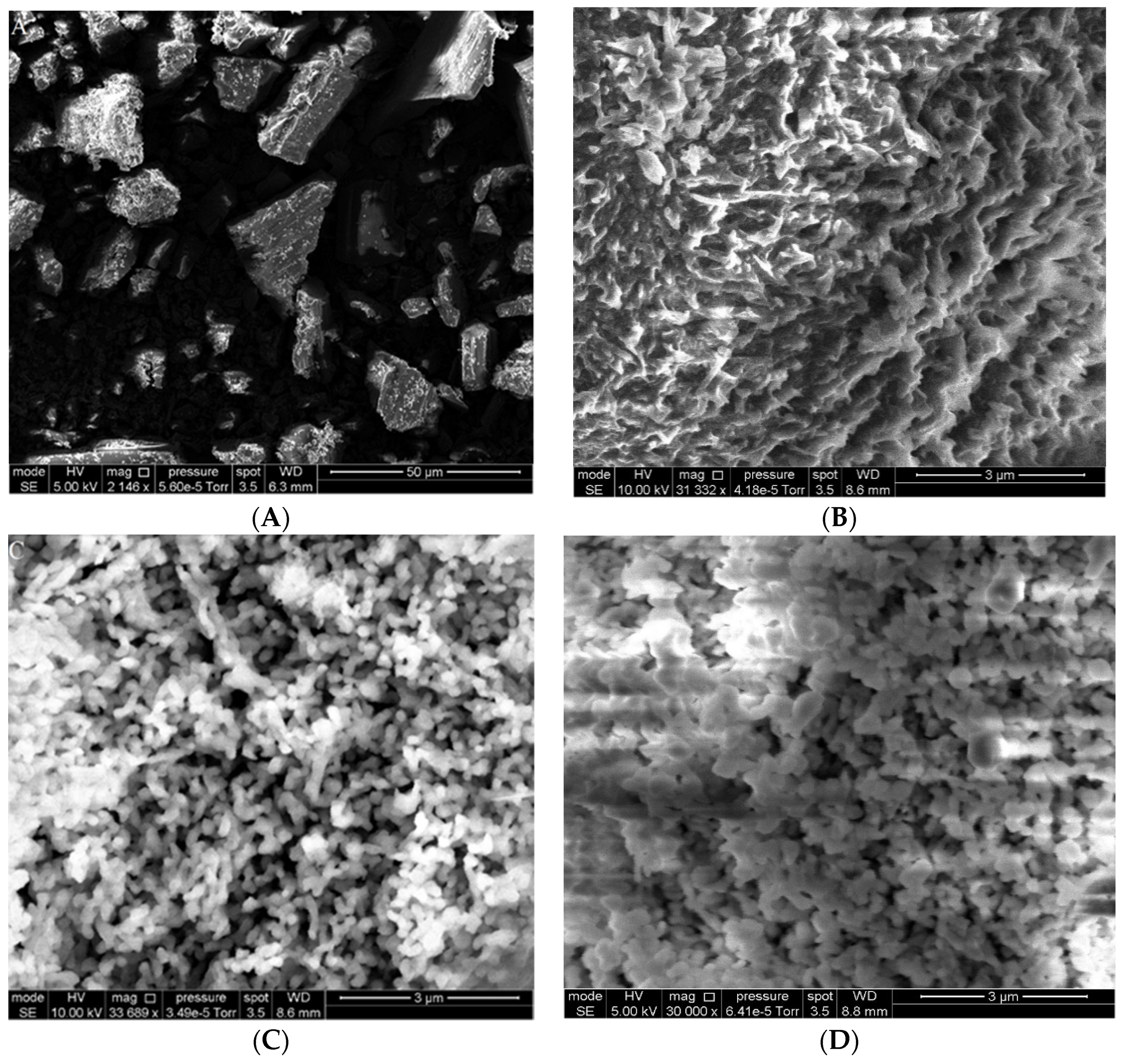


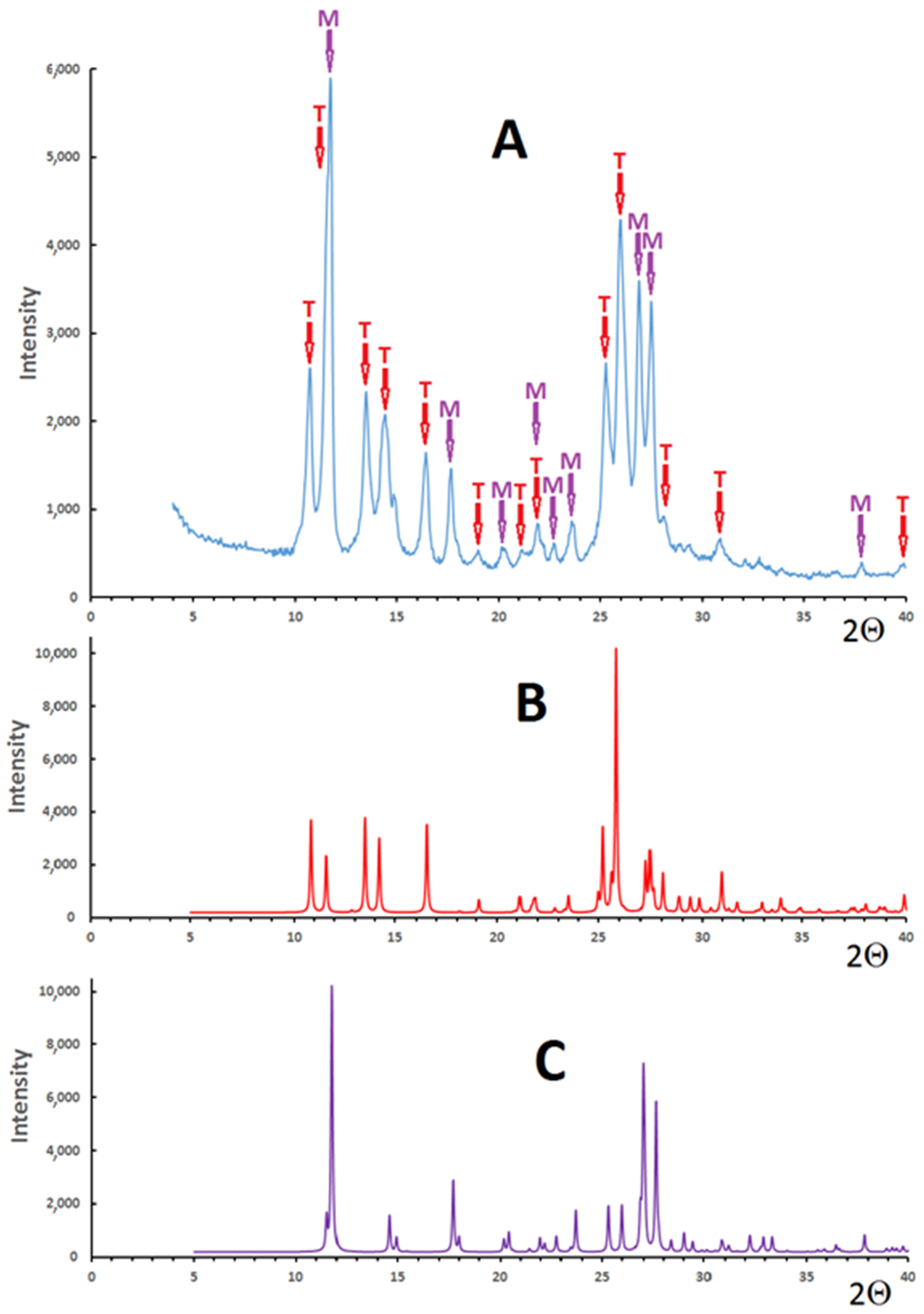
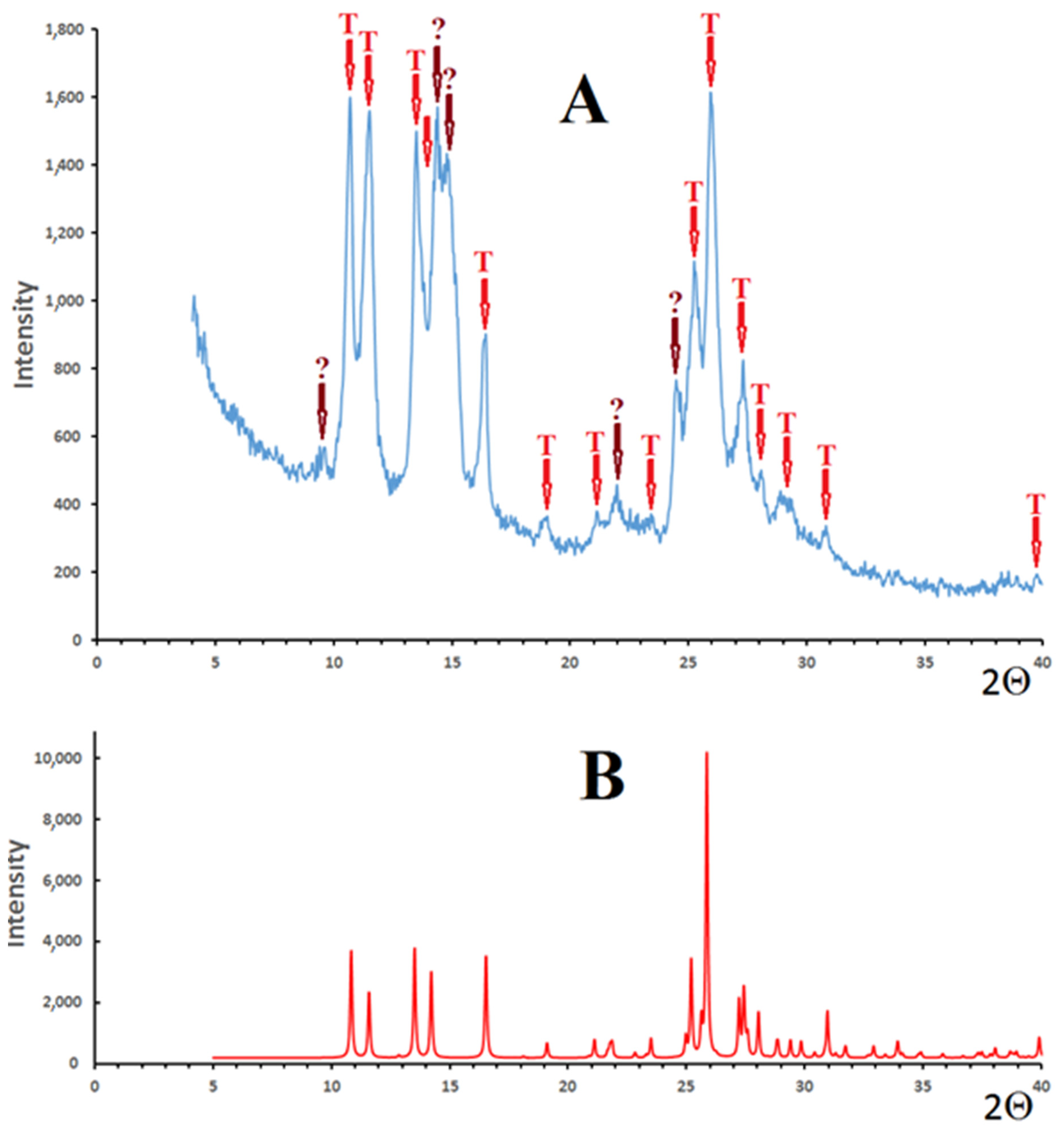
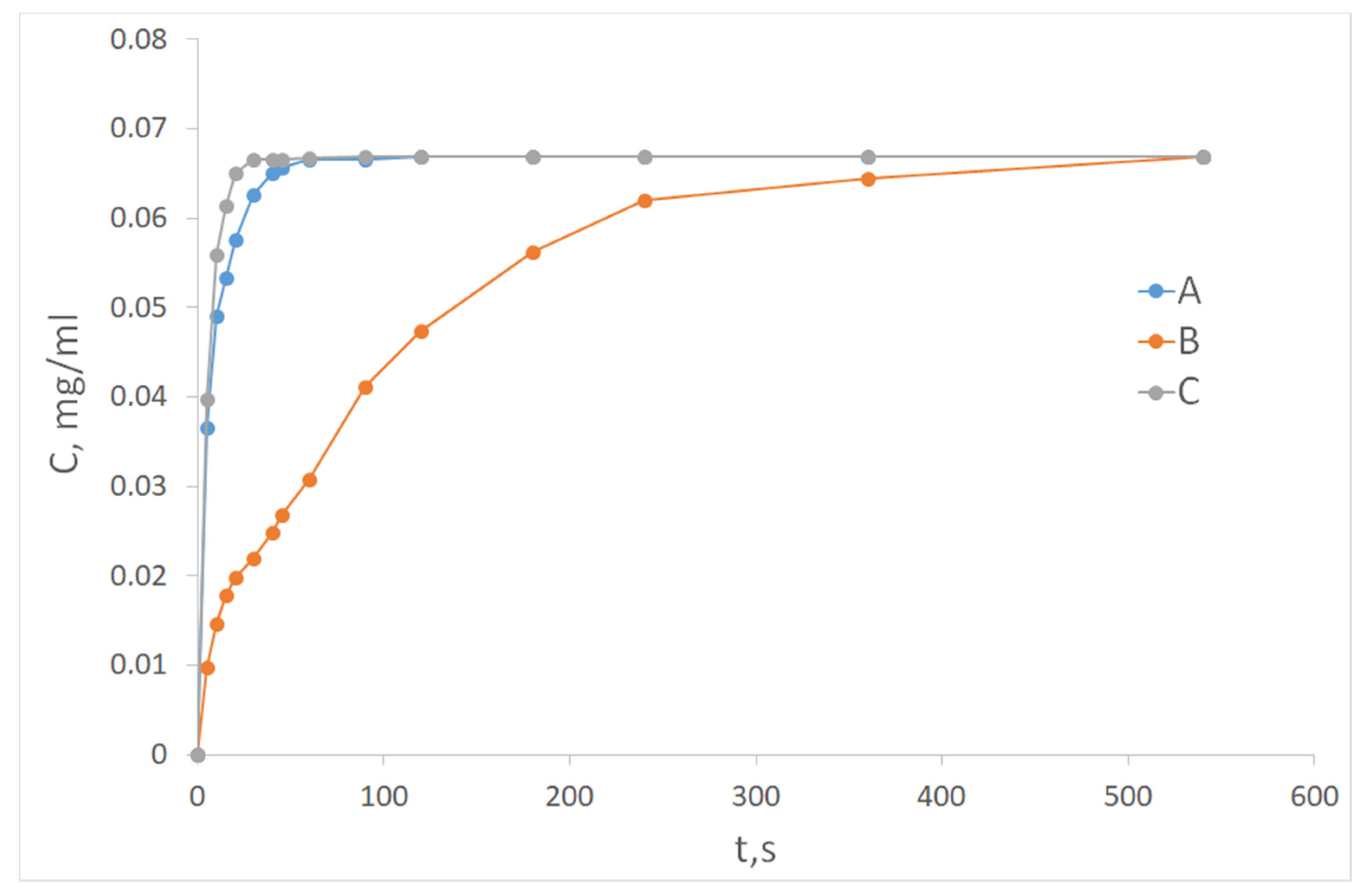
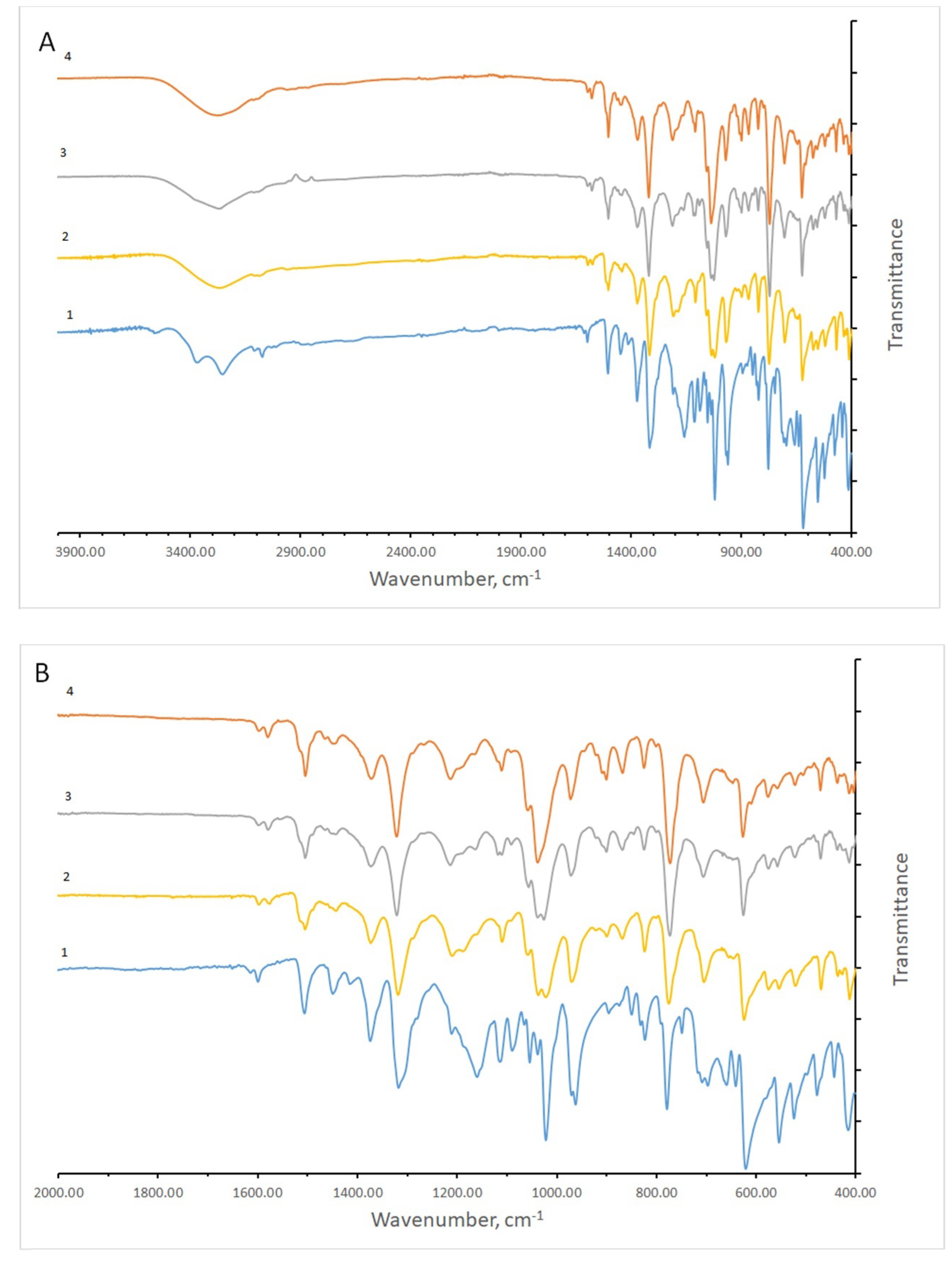

| Flow of CO2, Mole/h | Condensation Rate of Carrier Gas CO2, molecules s−1 cm−2 × 10−16 | The Ratio of Condensation Rates CO2/Dioxidine | Phase Composition | Specific Surface Area, m2/g | Particle * Size, nm |
|---|---|---|---|---|---|
| 0 | 0.0 | 0 | T:H = 7:1 | 9.6 | 414 ± 80 |
| 0.2 | 1.4 | 1.85 | T:M = 2:1 | 33 | 120 ± 24 |
| 0.45 | 3.1 | 4.16 | T:M = 1:1 | 34 | 118 ± 23 |
| 1.00 | 7.0 | 9.24 | T:M = 2:3 | 37 | 108 ± 22 |
| 4.5 | 31.4 | 41.63 | T:N = 3:2 | 71 | 56 ± 11 |
| 10.0 | 69.7 | 92.50 | T:N = 3:2 | 78 | 51 ± 10 |
Publisher’s Note: MDPI stays neutral with regard to jurisdictional claims in published maps and institutional affiliations. |
© 2021 by the authors. Licensee MDPI, Basel, Switzerland. This article is an open access article distributed under the terms and conditions of the Creative Commons Attribution (CC BY) license (https://creativecommons.org/licenses/by/4.0/).
Share and Cite
Shabatina, T.I.; Morosov, Y.N.; Soloviev, A.V.; Shabatin, A.V.; Vernaya, O.I.; Melnikov, M.Y. Cryochemical Production of Drug Nanoforms: Particle Size and Crystal Phase Control of the Antibacterial Medication 2,3-Quinoxalinedimethanol-1,4-dioxide (Dioxidine). Nanomaterials 2021, 11, 1588. https://doi.org/10.3390/nano11061588
Shabatina TI, Morosov YN, Soloviev AV, Shabatin AV, Vernaya OI, Melnikov MY. Cryochemical Production of Drug Nanoforms: Particle Size and Crystal Phase Control of the Antibacterial Medication 2,3-Quinoxalinedimethanol-1,4-dioxide (Dioxidine). Nanomaterials. 2021; 11(6):1588. https://doi.org/10.3390/nano11061588
Chicago/Turabian StyleShabatina, Tatyana I., Yurii N. Morosov, Andrey V. Soloviev, Andrey V. Shabatin, Olga I. Vernaya, and Michail Y. Melnikov. 2021. "Cryochemical Production of Drug Nanoforms: Particle Size and Crystal Phase Control of the Antibacterial Medication 2,3-Quinoxalinedimethanol-1,4-dioxide (Dioxidine)" Nanomaterials 11, no. 6: 1588. https://doi.org/10.3390/nano11061588
APA StyleShabatina, T. I., Morosov, Y. N., Soloviev, A. V., Shabatin, A. V., Vernaya, O. I., & Melnikov, M. Y. (2021). Cryochemical Production of Drug Nanoforms: Particle Size and Crystal Phase Control of the Antibacterial Medication 2,3-Quinoxalinedimethanol-1,4-dioxide (Dioxidine). Nanomaterials, 11(6), 1588. https://doi.org/10.3390/nano11061588






